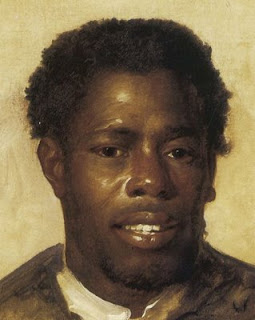From a review by Frank Freeman about Of Arms and Artists: The American Revolution Through Painters' Eyes :
Paul Staiti, a fine arts professor at Mount Holyoke College, has written a book about five painters who juggled the demands of art and the demands of history during the American Revolution and afterward.
Gilbert Stuart (1755-1828) was an apolitical, erratic genius from Rhode Island. Stuart was the most talented artist of the five, "the master artist of the early republic." He went to London, spent time with Benjamin West and John Trumbull, then returned to America with his creditors in hot pursuit. He drank too much, bathed too infrequently, was a felon who often never finished paintings he had been paid for, and sold commissions to other painters. Of course, everybody loved him. Stuart forged his artistic bond with George Washington. His portrait of the first president resides on the one dollar bill.
 |
| Archbishop John Carroll by Gilbert STUART (our country's first Catholic bishop) |
 |
| The artist John Trumbull by Gilbert STUART |
Connecticut-born John Trumbull (1756-1843) was a man who fought in the Revolution and witnessed the Battle of Bunker Hill. Because of perceived slights from Congress, he resigned his commission and devoted himself to painting. He went to London to study with Benjamin West, but also conspired to smuggle money and supplies to America, for which he was imprisoned. Edmund Burke, among notable others, secured his release from jail. Just as John Copley associated with John Adams, Trumbull associated with Jefferson, especially in Paris. If John Adams was a rigid and unimaginative man, Jefferson was creative and brilliant—although he is also depicted as cruel and manipulative.
... John Trumbull returned to America and, after a long series of unfinished projects, was able to practically single-handedly convince Congress to commission four huge paintings to be exhibited in the Capitol rotunda. Fortunately, during the Civil War Trumbull’s rotunda paintings were covered with canvas to prevent likely damage during the war. Such damage, Staiti writes, “would have been a tragic loss.”
 |
| Alexander Hamilton by John TRUMBULL |
 |
| Battle of Bunker Hill by John TRUMBULL |
John Singleton Copley (1738-1815), began his career in Boston and, like Benjamin West, ended up in London. Beer drinkers are unwittingly familiar with Copley’s painting of Samuel Adams. Copley is also famous for Watson and the Shark (1778) and for his portrait of Samuel Adams’ cousin, John Adams (1783), a portrait that Adams commissioned while seething with envy about the popularity of Washington, Ben Franklin, and Thomas Jefferson.
Benjamin West (1738-1820) of Pennsylvania never knew the trauma of war firsthand. With the help of patrons, he traveled to Europe while relatively young and settled in London, where he eventually became “court painter to King George III, who was both his friend and benefactor.” Incredibly, West supported the Revolution. “Given West’s Patriot Sympathies,” Staiti writes, “emerging unscathed from the Revolution was a political high-wire act of the first order.”
[As a child of an innkeeper's large family, some Indians taught him how to make paint from riverbank clay mixed with bear grease in a pot!]
 |
| Benjamin Franklin by Benjamin WEST |
 |
| "William Penn's Treaty with the Indians" by Benjamin WEST |
Charles Willson Peale (1741-1827) was a native of Maryland who apprenticed as a saddle-maker and then decided to learn to paint to earn more money. He did well studying with West... and then returned to an America embroiled in the Revolution. Peale fought with George Washington’s forces in 1776 along the Delaware—fought but also painted portraits of Washington as the war continued.
Peale’s Dante-esque description of war in the winter of 1776 is one of the most moving passages in the book.
In the middle of the nightmare scene Peale encountered a frightening stranger. “A man staggered out of the line and came toward me. He had lost all his clothes. He was in an old dirty blanket jacket, his beard long and his face full of sores … which so disfigured him that he was not known by me on first sight.” In few moments he realized who it was. “Only when he spoke did I recognize my brother James.” Ensign James Peale had escaped from New York [which the British had taken], staggered into Washington’s encampment, and then into the arms of his brother.
 |
| Thomas Jefferson by Charles Willson PEALE |
 |
| Nathanael Greene by Charles Willson PEALE (the Quaker who became Gen. Washington's ablest officer) |
Professor Staiti writes: "Unlike European states that could rely on ethnic bloodlines, class kinship, monarchic paternalism, and age-old systems of patronage to help people understand who they were, where they came from, and how they figured into the nation, America, with its fluid classes, immigrant influxes, unruly habits, individual rights, mixed histories, and differing religious, moral, political, social, and racial character, needed a single event—the Revolution—to create the bonds that might tie citizens to each other."
This book illustrates that chaotic process through five painters who captured it on canvas for posterity, for us.


No comments:
Post a Comment